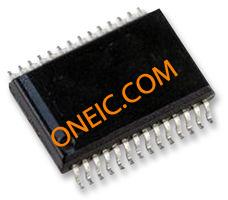PIC18LF26J11-I/SS
8-bit microcontrollers with 64KB Flash, 4KB RAM, and low power consumption
Manufacturer: microchip
series introduction
# Introduction to the PIC18LF26J11 - I/SS Product Series
## 1. Overview
The PIC18LF26J11 - I/SS is a member of Microchip Technology's PIC18LF family of 8 - bit microcontrollers. These microcontrollers are designed to offer a balance of performance, low power consumption, and rich peripheral features, making them suitable for a wide range of applications. The "I/SS" in the part number typically refers to a specific package type and temperature range, which in this case is a small - outline, surface - mount package, making it ideal for space - constrained designs.
## 2. Key Features
### 2.1 Core and Performance
- **8 - bit RISC CPU**: The PIC18LF26J11 is based on an 8 - bit Reduced Instruction Set Computing (RISC) architecture. This architecture simplifies the instruction set, allowing for faster execution times and efficient code utilization. It can execute most instructions in a single instruction cycle, which contributes to its overall performance.
- **Operating Frequency**: It can operate at a maximum frequency of up to 32 MHz. This relatively high clock speed enables the microcontroller to handle complex tasks and perform calculations quickly, making it suitable for applications that require real - time processing.
### 2.2 Memory
- **Program Memory**: The device comes with 32 KB of Flash program memory. Flash memory is non - volatile, which means that the program code stored in it is retained even when the power is turned off. This allows for easy reprogramming during development and in - field updates if required.
- **Data Memory**: It has 1536 bytes of Random Access Memory (RAM). RAM is used for storing variables, intermediate results, and data that needs to be accessed quickly during program execution.
- **EEPROM**: There is also 256 bytes of Electrically Erasable Programmable Read - Only Memory (EEPROM). EEPROM is useful for storing data that needs to be retained even after power cycling, such as configuration settings or calibration data.
### 2.3 Low - Power Operation
- **Multiple Power Modes**: The PIC18LF26J11 offers several power - saving modes, including Sleep, Idle, and Doze modes. In Sleep mode, the microcontroller consumes the least amount of power as most of the internal circuits are shut down, while still retaining the contents of the RAM. This makes it suitable for battery - powered applications where power consumption is a critical factor.
- **Low - Voltage Operation**: It can operate at a wide range of supply voltages, typically from 2.0V to 5.5V. This flexibility allows for integration with different power sources and also helps in reducing power consumption when operating at lower voltages.
### 2.4 Peripherals
#### 2.4.1 General - Purpose Input/Output (GPIO)
- The microcontroller has a number of GPIO pins that can be configured as either inputs or outputs. These pins can be used to interface with external devices such as sensors, switches, LEDs, and other digital components. The GPIO pins are also programmable, allowing for features like pull - up or pull - down resistors to be enabled.
#### 2.4.2 Analog - to - Digital Converter (ADC)
- It is equipped with a 10 - bit ADC. The ADC can convert analog signals from external sensors (such as temperature sensors, light sensors, or potentiometers) into digital values that can be processed by the microcontroller. With multiple input channels, it can sample different analog signals simultaneously or sequentially.
#### 2.4.3 Timers/Counters
- There are several timers and counters available on the PIC18LF26J
Images for reference

28-SSOP, M28

28-SOIC

Image Preview